Submitted by Emina Čamdžić
The Elements of Climate Resilient Buildings
Bosnia and Herzegovina Architecture News - Aug 19, 2024 - 12:56 7315 views
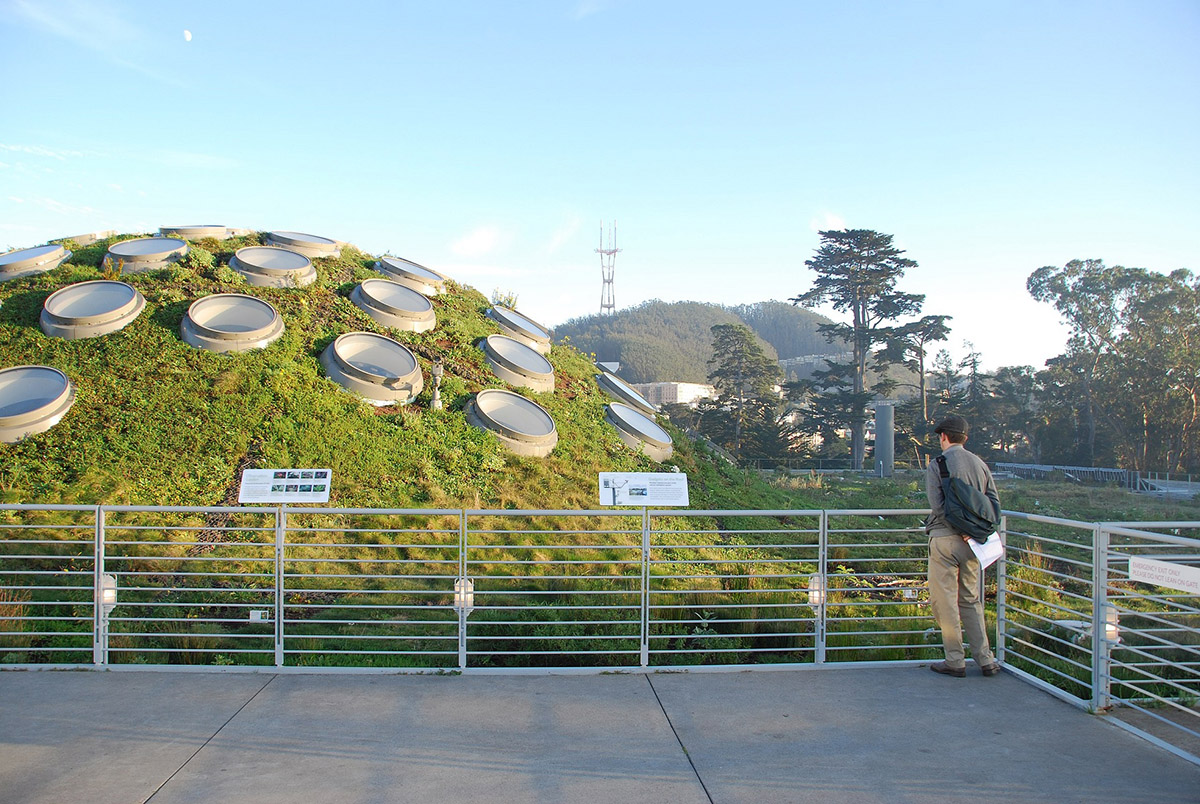
This article, written by the World Architecture Community's Bosnia and Herzegovina Country Reporter and architect Emina Čamdžić, shows how particular elements of buildings introduce resilience to climate change.
In general knowledge, it’s visible nowadays that during the summer are numerous examples of extreme climate changes such as too high air temperatures not usual for the summer days, or winds with storms and huge ice cubes falling from the sky while the winds take away the roofs and break tree branches. Only in several months, the climate has impacted daily life so drastically that weather warnings and heat warnings have been a common thing to watch out for. Nevertheless, for people, it is hard to get used to such weather, even if air condition units are constantly on in all buildings almost all day long. The extreme weather has gone so far that the normal temperature conditions have jumped over 38 degrees Celsius, while according to the Federal Hydrometeorological Institute of BiH, the air temperatures have risen dramatically in the last two decades, which has further on their website1 issued a warning for high air temperatures, that possible infrastructure damages are to be expected and that the heatwaves present a danger to health.
Climate change has affected the way that buildings are being built on the site, as the weather changes affect the time and days it is worked on the building sites. It can be said that there are fewer normal working days and more days when it is not possible to build or should be avoided.

Image shows example of safety measures. Image © Michael Garlick 2 via Wikimedia Commons
Green roofs offer trees for shade and temporary cooling, while the plants on the green roof as well as trees purify the air and use the CO2 from the air for photosynthesis. By definition in architecture, green roofs are flat walkable roofs renovated or newly built, covered fully with grass and plants or trees. Green roofs offer places for insects of all kinds, supporting biodiversity, improving the thermal insulation of the roof, reducing ambient temperature, and allowing better drainage. Green roofs use rainwater for the growth of the grass and plants, although there can be added watering systems for the whole roof. It is good for relaxing, and enjoying the imitation of a natural landscape in an urban town, while at the same time can be good for organizing events, or just for gardening some plants. There are even some urban gardens that are often placed on roofs and can be added to green roofs. There are examples of some houses in Europe either in urban or rural areas that have sloped green roofs and often with green walls.
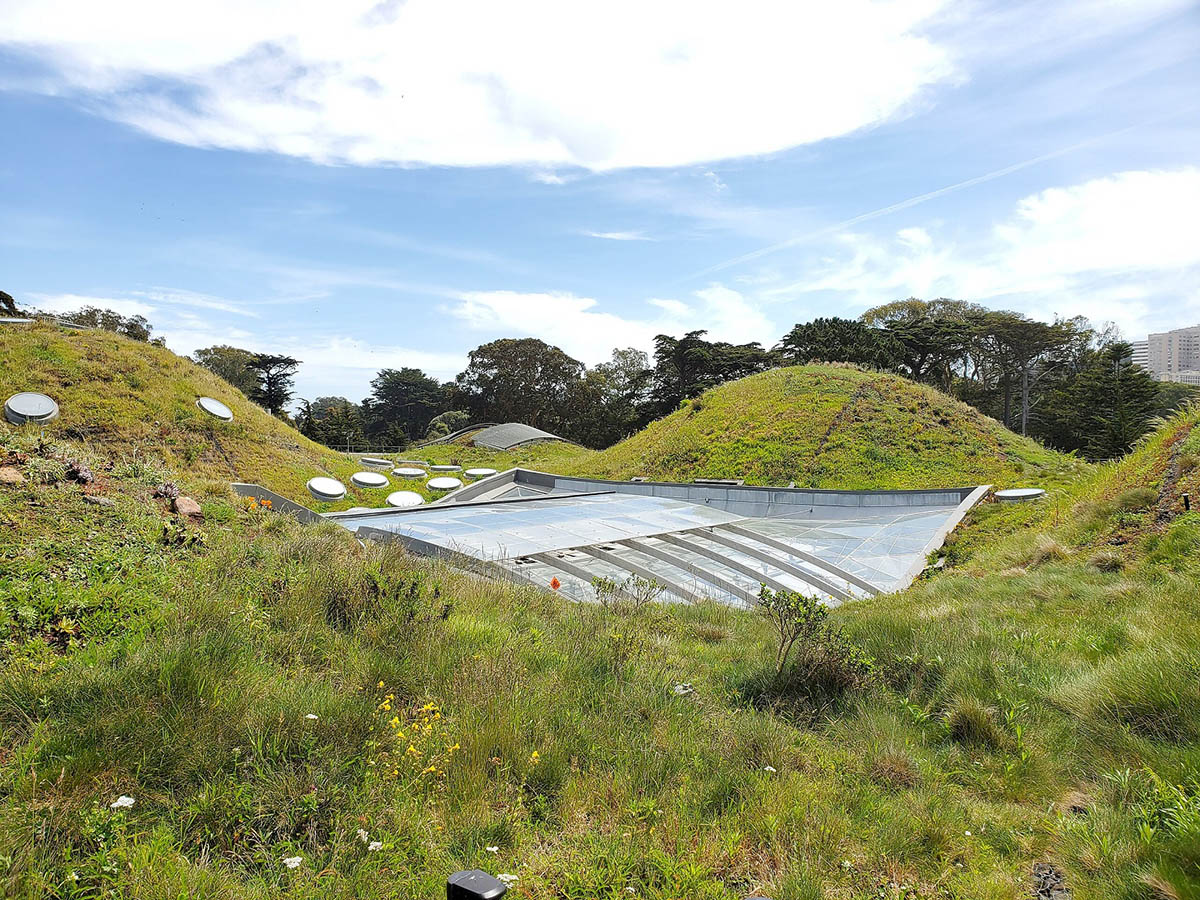
Image shows example of a green curved roof with glass openings. Image © Buzzlovestravel 3 via Wikimedia Commons
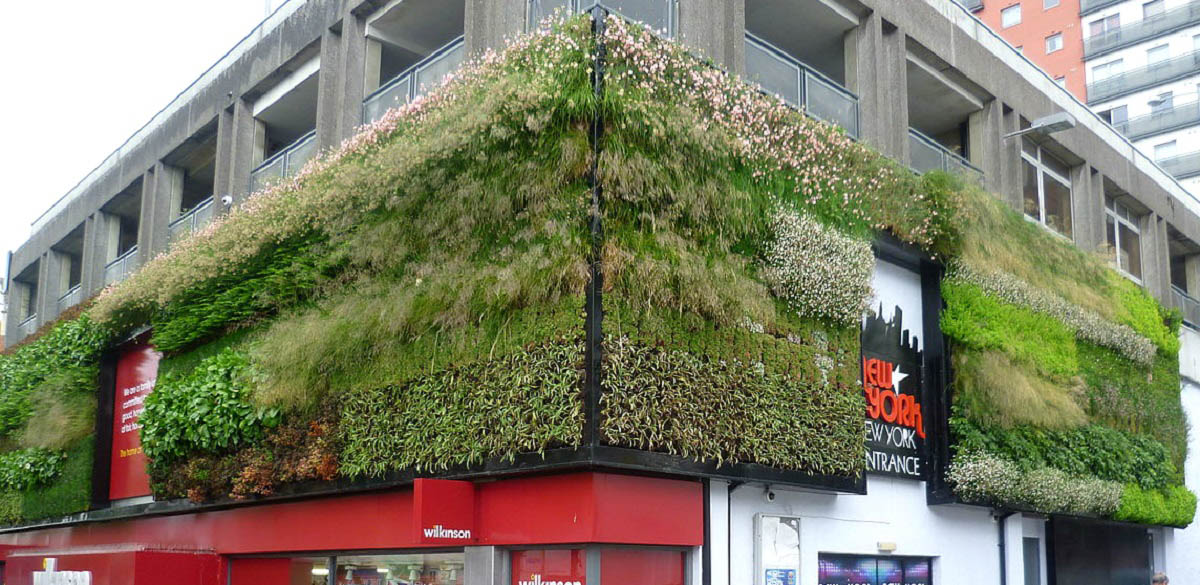 Image shows example of a green wall on an existing building. Image © Marathon 4 via Wikimedia Commons
Image shows example of a green wall on an existing building. Image © Marathon 4 via Wikimedia Commons
Some options for electrical energy are the hybrid combination of a green roof with the solar roof, where a solar energy would provide enough or a certain percentage of energy for the building using renewable energy, while the green roof purifies the urban air and upgrades air quality in the area.
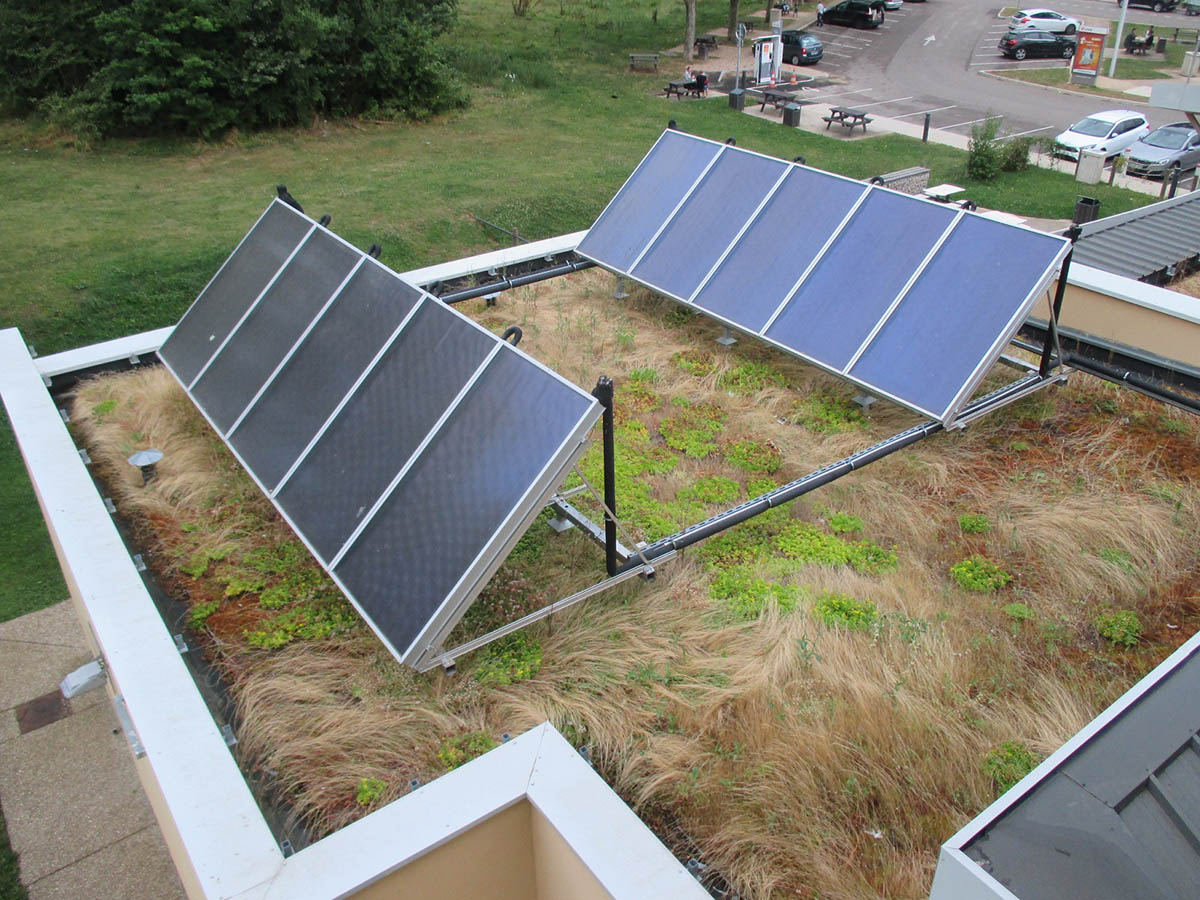
Image shows example of a hybrid green roof with PV solar panels. Image © Arnaud 25 5 via Wikimedia Commons
The accelerated lifestyle while technology occupies daily lives and cities have higher density, it’s important to reconnect with nature and the natural life. A popular approach in architecture is biophilic design, which basically adds natural features to the interior of the buildings. More about this theme is mentioned in previous articles written for the World Architecture Community that can be read on this page.
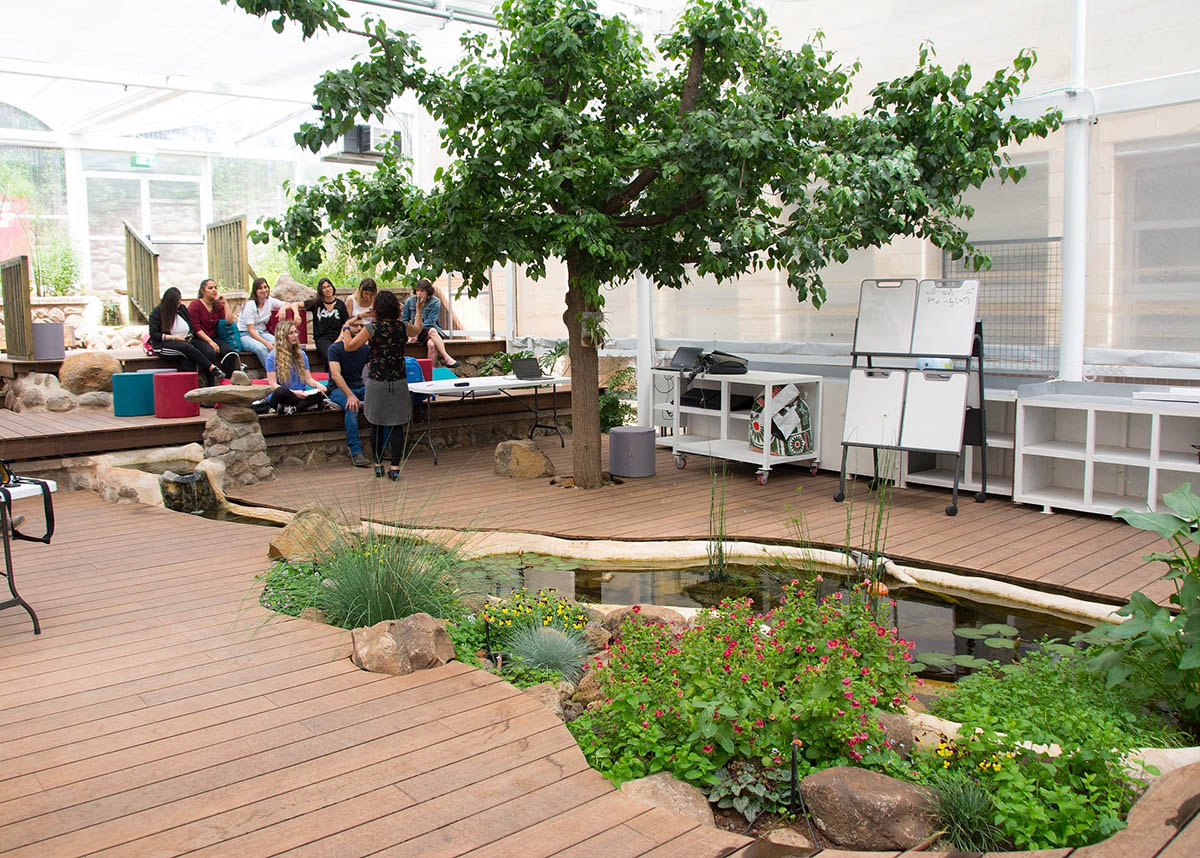
Image shows example of a biophilic design in the building interior. Image © Ohalo123 6 via Wikimedia Commons
There is an individual and city scale of sustainability
Climate change and the loss of biodiversity is not only an environmental crisis but affects the surrounding ecosystems, social and economic crises as well.
For architecture, energy efficiency means saving energy, environment, and resources. The role of good and great architecture is also to improve the life and health of people who spend time there and ecosystem health.
- Indoor dust is just one of the challenges solved by greenery and vegetation indoors. Optimization of building elements and finishes of each element is crucial to the interior feeling and healthy surrounding indoors.
- Acoustic solutions in nature and noise control are just some of the benefits of vegetation indoors, in addition to the triple-glazed windows and glass systems. Increased tree coverage and green spaces are part of the acoustic solutions and reduction of indoor air pollution.
- Regenerative interiors for example include biobased materials, free of plastic and chemicals in the furniture and synthetic fibre which are making a positive impact on the surrounding ecology and the community.
- A webinar by the RIBA (Royal Institute of British Architects) explains that the difference between single, ordinary, double, advanced, vacuum, and triple-glazed windows is in the U-value comparison by window type, therefore the triple-glazed windows have the lowest U-value which is below 1, while the single glazed has the largest U-value which is up to 5, which leads to thermal energy loss, indoor cooling, and increased humidity.
- Architecture can function as an energy system. Solar glazing is made to admit direct sunlight into the interior space for passive heating during winter, enough sunlight on an average sunny winter day to heat a space over the full 24-hour period. The percentage of the floor area to be heated in cold climates is 16 to 20 percent, while in mild climates is 10 to 13 percent, as stated in the aforementioned RIBA webinar.
- Lowering energy demands by solar photovoltaic panels for electricity generation represents the on-site energy. The photovoltaic (PV) system uses several solar modules that are made of many solar cells, and those generate electrical power. By using PV solar panels, the building becomes energy-sustainable.
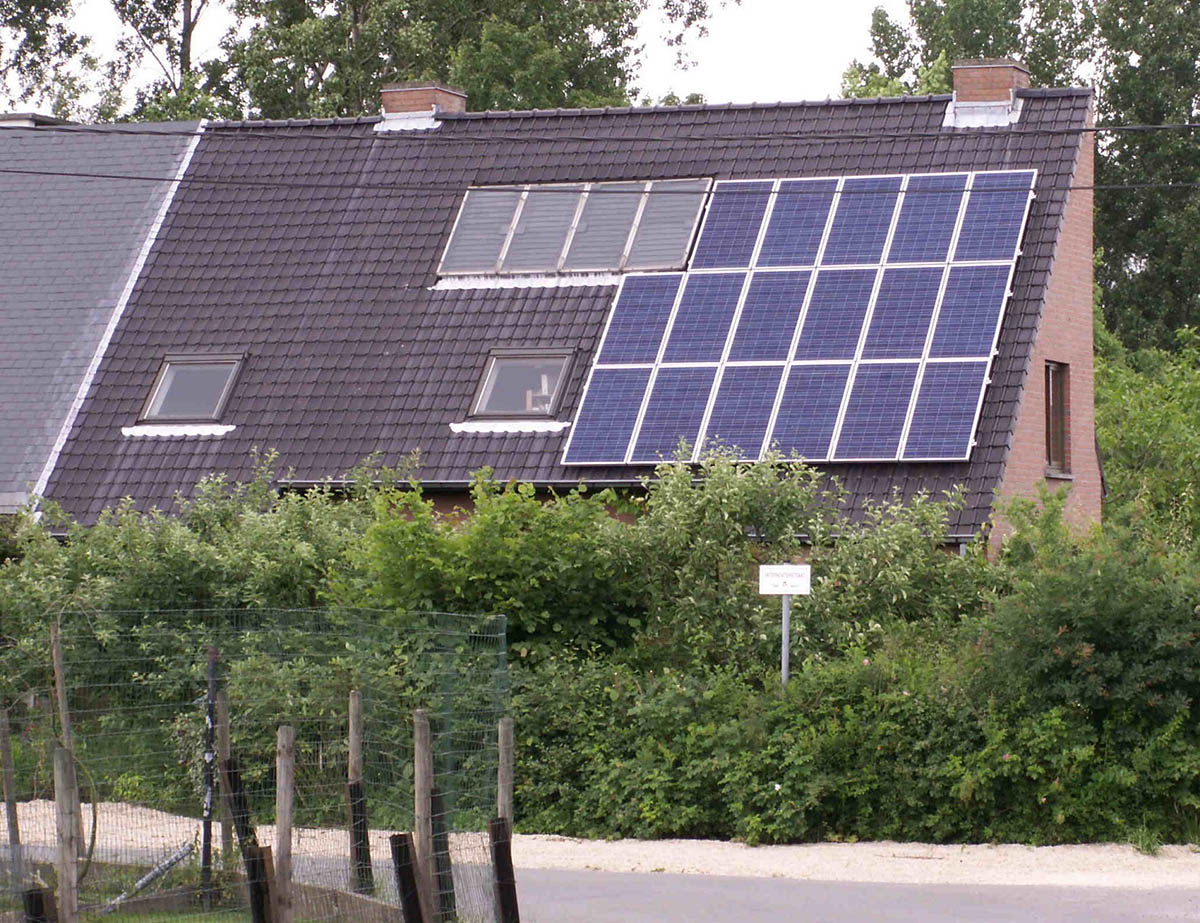
Image shows example of PV solar panels on a family house with a sloped roof. Image © KVDP 7 via Wikimedia Commons
Climate scientists confirmed that July of the previous year and this year were the world's hottest months on record with global average temperature exceeding previous records by a substantial margin. It is claimed that buildings are responsible for 39% of GHG (Greenhouse gas) emissions. More information can be found on this website.

Image shows the planet Earth and importance of sustainability, green vegetation and water resources. Image © Freepik, AI 8 via Freepik.com
The changing climate has influenced the way buildings function as well as electronic devices because due to the extreme heatwaves plastic and galvanized plastic are breaking and melting, more and more air condition units are used for the warmest days of the year, there are power outages in the system of the country, and the thought of using renewable energy resources for electricity and heating – cooling is already a starting point to work on.
Top image in the article: Example of the green roof, California Academy of Sciences - Roof. Image by FASTILY. Retrieved 12 August, 2024 from (https://commons.wikimedia.org/wiki/File:California_Academy_of_Sciences_-_Roof_1_2016-11-12.jpg) via Wikimedia Commons (CC BY-SA 4.0). Copy-Paste into your browser.
1. Website for the Federal Hydrometeorological Institute of BiH, warning for high air temperatures. Retrieved 12 August, 2024 (https://www.fhmzbih.gov.ba/latinica/AKTUELNO/upozorenja.php). Copy-Paste into your browser.
2. Image: The Clandon Park Mansion: Safety preparations prior to entry. Image by Michael Garlick. Retrieved 12 August, 2024 from (https://commons.wikimedia.org/wiki/File:Clandon_Park_Mansion,_Safety_preparations_prior_to_entry_2_-_geograph.org.uk_-_5588229.jpg) via Wikimedia Commons (CC BY-SA 2.0). Copy-Paste into your browser.
3. Image: The roof at the California Academy of Sciences in San Francisco, CA. Image by Buzzlovestravel. Retrieved 15 August, 2024 from (https://commons.wikimedia.org/wiki/File:TheRoofAtTheCaliforniaAcademyOfSciences.jpg) via Wikimedia Commons (CC BY-SA 4.0). Copy-Paste into your browser.
4. Image: Green wall, Sutton town centre. Image by Marathon. Retrieved 15 August, 2024 from (https://commons.wikimedia.org/wiki/File:Green_wall,_Sutton_town_centre_(geograph_3014019).jpg) via Wikimedia Commons (CC BY SA 2.0). Copy-Paste into your browser.
5. Image: Solar panels on a green roof. Image by Arnaud 25 . Retrieved 15 August, 2024 from (https://commons.wikimedia.org/wiki/File:Panneau_solaire_03.jpg) via Wikimedia Commons (CC BY-SA 4.0). Copy-Paste into your browser.
6. Image: The Ohalo biophilic learning space. Image by Ohalo123. Retrieved 15 August, 2024 from (https://commons.wikimedia.org/wiki/File:Ohalo_biophilic_learning_space02.jpg) via Wikimedia Commons (CC BY-SA 4.0). Copy-Paste into your browser.
7. Image: A house with both solar photovoltaic (PV) and thermodynamic panels. Image by KVDP. Retrieved 15 August, 2024 from (https://commons.wikimedia.org/wiki/File:ThermodynamicVSPhotovoltaicpanels.jpg) via Wikimedia Commons (Public domain). Copy-Paste into your browser.
8. Image: Sustainable travel concept. Image by Freepik, AI. Retrieved 15 August, 2024 (https://www.freepik.com/free-ai-image/sustainable-travel-concept_95019536.htm) via Freepik.com (Free license). Copy-Paste into your browser.
